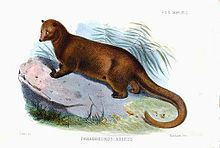Kingdom Animalia Suborder Feliformia Phylum Chordata Rank Species | Class Mammalia Family Viverridae Genus Paradoxurus Order Carnivores | |
 | ||
Similar Western lowland olingo, Bourlon's genet, Leighton's linsang, King genet, Johnston's genet | ||
Paradoxurus aureus, the golden palm civet, also called golden paradoxurus and golden wet-zone palm civet is a viverrid species native to Sri Lanka. It was first described by Frédéric Cuvier in 1822.
Contents
Characteristics
The head and body length of the golden palm civet is 55cm, and its tail measures 40-50cm.
Uniform reddish gold to golden brown upperparts. Adults are red-gold to golden brown, with no special markings. The underside is paler gold. It has moderately soft fur, which can be glossy and densely covered throughout the body and tail. Tail tip can be white or pale brown. As other viverrids, ears are prominent, rounded and edges with hairless. Eyes are larger due to nocturnal habit, and are with vertical pupils.
Habitat
It is found in forest, the foothills and the areas in between and possibly the cloud forest in the Central Highlands, Namunukula, and the Knuckles Mountain Range (Dumbara). Paradoxurus aureus was formerly considered synonymous with Paradoxurus zeylonensis, but is now considered a distinct species.
Taxonomy
Initially, all three endemic civet species in Sri Lanka was considered as a single species. But recent phylogenetic experiments, genetic makeup and morphogenetics, single species Paradoxurus aureus was split into three separate species in th same genus Paradoxurus. The other two endemic species are Paradoxurus montanus and Paradoxurus stenocephalus.
